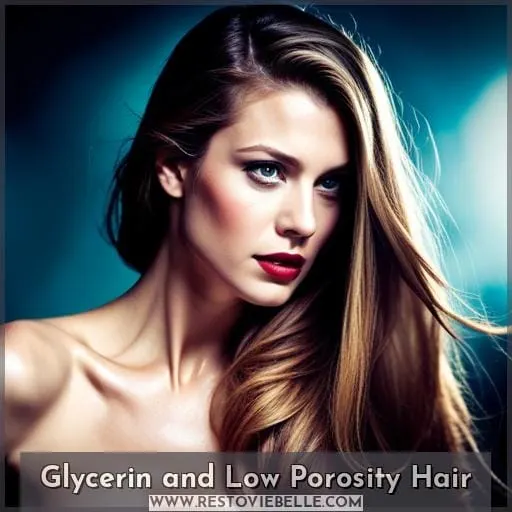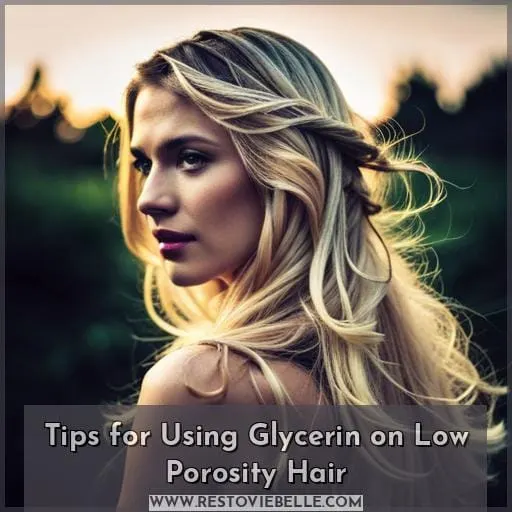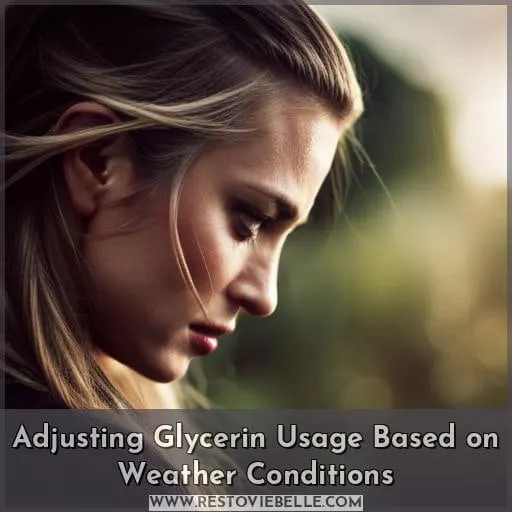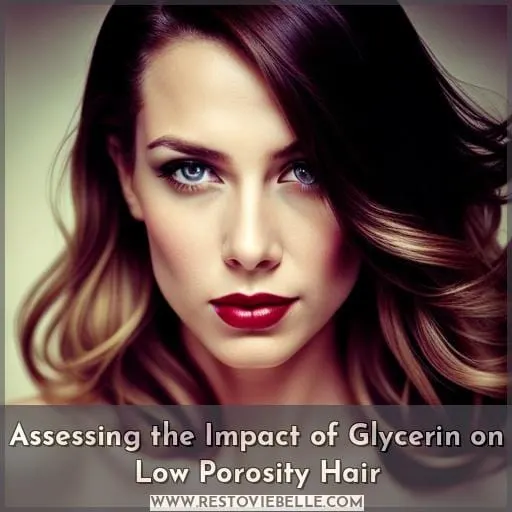This site is supported by our readers. We may earn a commission, at no cost to you, if you purchase through links.
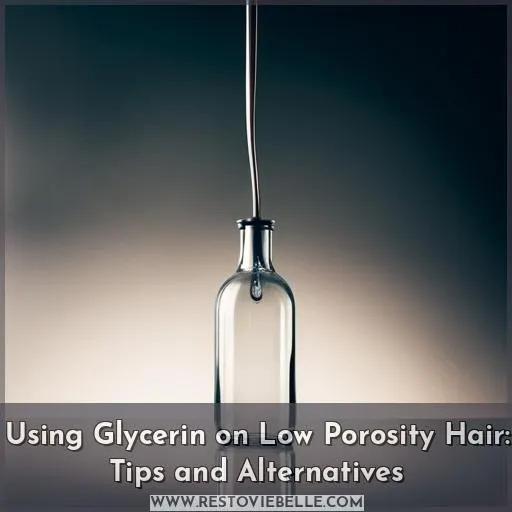 Discover the secrets to nourishing your low porosity hair with glycerin.
Discover the secrets to nourishing your low porosity hair with glycerin.
Learn how this powerful ingredient can benefit your locks and overcome potential challenges.
With expert tips on proper usage, including dilution and layering techniques, you’ll achieve optimal results for hydrated and healthy hair.
Explore alternative options to glycerin for those seeking different moisturizing alternatives.
Take control of your hair’s moisture balance and unlock the full potential of your low porosity strands with these helpful insights.
Table Of Contents
- Key Takeaways
- Glycerin and Low Porosity Hair
- Tips for Using Glycerin on Low Porosity Hair
- Adjusting Glycerin Usage Based on Weather Conditions
- Alternatives to Glycerin for Low Porosity Hair
- Assessing the Impact of Glycerin on Low Porosity Hair
- Frequently Asked Questions (FAQs)
- Can glycerin be used on low porosity hair without causing buildup or weighing the hair down?
- Are there any specific tips or techniques for applying glycerin to low porosity hair to ensure maximum absorption and effectiveness?
- How does the weather or climate affect the use of glycerin on low porosity hair? Are there certain conditions where glycerin should be avoided?
- What are some alternative ingredients or products that can provide similar benefits to glycerin for low porosity hair?
- How can I determine the impact of glycerin on my low porosity hair? Are there any signs or indicators to look out for to assess its effectiveness?
- Conclusion
Key Takeaways
- Glycerin can aid in moisture retention for low porosity hair by attracting water molecules.
- Diluting glycerin and layering with hydrating products can enhance its effectiveness.
- Climate adaptation is crucial for optimal glycerin usage on low porosity hair.
- Personalized experimentation is necessary to find the best approach for managing and nourishing low porous strands.
Glycerin and Low Porosity Hair
Now let’s talk about the relationship between glycerin and low porosity hair.
Low porosity hair tends to have tightly closed cuticles, making it more difficult for moisture to penetrate and be retained.
While glycerin can still benefit low porosity hair by attracting moisture, there are some potential challenges to consider.
Let’s explore the benefits of using glycerin on low porosity hair as well as some tips for optimal results.
Understanding Low Porosity Hair
To understand the effects of glycerin on low porosity hair, it’s important to grasp the unique characteristics and needs of your hair.
Low porosity hair has tightly closed cuticles that make it difficult for moisture to penetrate. Understanding this will help you tailor your moisturizing techniques accordingly.
Here are four key points to consider when dealing with low porosity hair:
- Hair Absorption: Low porosity hair struggles with absorbing moisture due to its tightly packed cuticles.
- Moisture Retention: Glycerin helps in retaining moisture by attracting and holding water molecules.
- Humectants Exploration: Experimenting with different humectants can provide insights into their effectiveness on low porosity strands.
- Climate Adaptation: Adjusting glycerin usage based on weather conditions ensures optimal results for your low porosity locks.
By understanding these aspects, you can effectively utilize glycerin as a tool in managing and nourishing your low porous tresses while adapting to varying climates.
Benefits of Glycerin for Low Porosity Hair
If you have low porosity hair, glycerin can provide numerous benefits for your strands.
Glycerin is a powerful humectant that helps balance humidity levels and improve hair moisture retention. It enhances the absorption of moisture into the hair shaft, resulting in better hydration and increased elasticity.
Incorporating glycerin into your hair care routine can help combat dryness and promote healthier, more hydrated locks.
However, it’s important to note that some individuals with low porosity hair may experience challenges with using glycerin due to its potential for build-up or weighing down the strands.
| Benefits of Glycerin |
|---|
| Enhances Hair Moisture Retention |
| Balances Humidity Levels |
| Improves Hair Absorption |
Potential Challenges With Glycerin on Low Porosity Hair
When using glycerin on low porosity hair, it’s important to be aware of the potential challenges that may arise.
Low porosity hair has a tightly packed cuticle layer that makes it difficult for moisture to penetrate.
Glycerin, being a humectant, attracts moisture from the environment and can disrupt the delicate balance of moisture in low porosity hair.
This can lead to issues such as excessive frizz and lack of hydration.
To overcome these challenges, consider enhancing absorption by diluting glycerin or layering with other moisturizing ingredients.
Climate adaptation and personalized experimentation are also key in finding alternatives that work better for your low porosity hair.
Tips for Using Glycerin on Low Porosity Hair
When using glycerin on low porosity hair, it’s important to:
- Dilute the glycerin with water or other moisturizing ingredients.
- This helps improve its absorption into the hair shaft and prevents any potential stickiness or heaviness.
- Layering glycerin with other hydrating products such as aloe vera gel or oils can enhance its effectiveness in providing moisture to low porosity hair.
- Avoid excessive use of glycerin as it can lead to build-up and weigh down the hair strands.
Diluting Glycerin for Better Absorption
For better absorption, dilute glycerin with water or aloe vera gel to help low porosity hair retain moisture more effectively.
Enhancing the absorption of glycerin is crucial in maintaining a proper moisture balance for this hair type. By diluting it with water or aloe vera gel, you can ensure that the humectant properties of glycerin penetrate your strands and provide optimal hydration.
Experimenting with different product combinations and considering climate considerations will further enhance your results.
Layering Glycerin With Other Moisturizing Ingredients
To enhance the moisturizing effects of glycerin on low porosity hair, layer it with other nourishing ingredients.
- Combine glycerin with aloe vera gel to provide additional hydration and soothing properties.
- Mix glycerin with natural oils like coconut or argan oil to seal in moisture and add shine.
- Pair glycerin with shea butter or cocoa butter for deep conditioning and added softness.
Avoiding Excessive Use of Glycerin
To avoid overusing glycerin on low porosity hair, remember to be mindful of the amount you apply.
While glycerin can provide moisture and hydration to your hair, excessive use can lead to a sticky and weighed-down feeling.
It’s important to adjust the application of glycerin based on your hair porosity and the weather conditions.
Incorporating it into your hair care routine in moderation will help prevent any potential issues associated with excessive use of glycerin.
Adjusting Glycerin Usage Based on Weather Conditions
When it comes to using glycerin on low porosity hair, adjusting your usage based on weather conditions is crucial.
In high humidity environments, where the air is already saturated with moisture, using glycerin can lead to frizz and excessive swelling of the hair.
On the other hand, in low humidity environments where there’s minimal moisture in the air, glycerin can actually draw out moisture from your hair, leaving it dry and brittle.
Understanding how weather impacts glycerin’s effectiveness will help you make informed decisions about when and how to incorporate it into your hair care routine.
High Humidity Environments
In high humidity environments, adjust your usage of glycerin to maintain optimal moisture levels in low porosity hair.
High humidity can cause excess moisture absorption, leading to frizz and loss of definition.
To manage this, consider reducing the amount or frequency of glycerin-based products during periods of high humidity.
Experiment with alternative humectants like aloe vera gel or honey that may provide better results in humid conditions.
Proper moisture management is essential for controlling frizz and maintaining healthy hair in different weather climates.
Low Humidity Environments
When you’re in a low humidity environment, it’s important to adjust your usage of glycerin on low porosity hair.
- Limit the amount of glycerin used: In low humidity environments, too much glycerin can draw moisture out of the hair instead of retaining it.
- Opt for lighter moisturizers: Look for hydrating products that contain ingredients like lightweight oils or butters to maintain moisture balance without relying solely on glycerin.
- Consider alternative humectants: If you find that your hair doesn’t respond well to glycerin in low humidity, try other humectants like honey or aloe vera gel which may be more suitable.
- Use protective styles and accessories: To minimize exposure to dry air and prevent excessive moisture loss, consider wearing updos or incorporating headscarves and hats into your hairstyle choices.
Alternatives to Glycerin for Low Porosity Hair
When it comes to low porosity hair, there are alternatives to glycerin that can provide similar benefits.
Natural oils and butters like coconut oil, shea butter, and jojoba oil can help moisturize and seal in moisture without weighing down the hair.
Aloe vera gel is another option that provides hydration while also soothing the scalp.
Honey is a natural humectant that attracts moisture to the hair strands, making it a great alternative for those with low porosity hair.
Natural Oils and Butters
Consider incorporating natural oils and butters as alternatives to glycerin for low porosity hair, providing nourishment and moisture retention.
Natural oils like coconut oil, argan oil, and jojoba oil are known for their hydrating properties that help lock in moisture.
Butters such as shea butter and mango butter also provide intense hydration while protecting the hair from environmental damage.
Experiment with different combinations of these ingredients to find the perfect balance for your low porosity hair’s needs.
Aloe Vera Gel
Continuing the exploration of alternatives to glycerin for low porosity hair, incorporating aloe vera gel into your hair care routine can be beneficial.
Aloe vera gel offers various advantages such as scalp benefits, sun protection, and effective styling.
When considering alternatives to glycerin based on your hair’s needs and preferences, aloe vera gel is worth exploring for its hydrating effects and versatility in hair care routines.
Honey
To explore alternatives to glycerin for low porosity hair, another option worth considering is honey.
Honey offers similar benefits as glycerin with its natural humectant properties that attract and retain moisture in the hair. It can help maintain hydration levels and improve moisture balance, especially in dry climates or during colder months.
Experimenting with honey-based products or DIY treatments can be a hydrating strategy for those seeking an alternative to glycerin while catering to their low porosity hair needs.
Assessing the Impact of Glycerin on Low Porosity Hair
When it comes to assessing the impact of glycerin on low porosity hair, it’s important to remember that everyone’s hair is unique and may respond differently. Experimentation and observation are key in determining whether glycerin works well for your specific hair type.
Pay attention to how your hair feels, looks, and behaves after using products containing glycerin, as this will help guide you towards optimal results.
Personal Hair Response to Glycerin
Assessing the impact of glycerin on low porosity hair is essential to understand how your individual hair responds to this humectant.
Hair porosity, moisture retention, and hydration strategies are key factors in determining the compatibility of glycerin with your hair type.
Additionally, environmental effects such as weather can impact the effectiveness of glycerin for different individuals.
Experimentation and observation will help you find the optimal balance for hydrating your low porosity hair while avoiding any potential challenges that may arise from using glycerin.
Experimentation and Observation for Optimal Results
When experimenting with glycerin on low porosity hair, it’s essential to observe and assess its impact for optimal results.
- Understanding Hair Reaction: Experimenting helps you understand how your hair reacts to glycerin, allowing you to tailor your routine accordingly.
- Climate Adaptation: By observing the weather impact on your hair’s moisture levels, you can adjust the amount of glycerin used based on dew points and humidity.
- Moisturizing Alternatives: Experimentation allows you to discover alternative moisturizing products that work well with low porosity hair.
By taking a hands-on approach and paying close attention to how your hair responds, you can find the perfect balance between hydration and avoiding product buildup or excessive frizz caused by high humidity environments.
Frequently Asked Questions (FAQs)
Can glycerin be used on low porosity hair without causing buildup or weighing the hair down?
Yes, glycerin can be used on low porosity hair without causing buildup or weighing it down.
Its humectant properties help attract and retain moisture in the hair, promoting hydration and enhancing manageability for those with low porosity strands.
Are there any specific tips or techniques for applying glycerin to low porosity hair to ensure maximum absorption and effectiveness?
To ensure maximum absorption and effectiveness of glycerin on low porosity hair, it’s essential to apply it on damp or wet hair. This allows the humectant properties of glycerin to attract and retain moisture more effectively, promoting hydration for your locks.
How does the weather or climate affect the use of glycerin on low porosity hair? Are there certain conditions where glycerin should be avoided?
Glycerin can be used on low porosity hair, but its effectiveness depends on the weather or climate.
In high humidity, it may cause frizz and loss of definition.
In dry climates, it can lead to moisture loss.
Adjust usage accordingly for optimal results.
What are some alternative ingredients or products that can provide similar benefits to glycerin for low porosity hair?
For low porosity hair, alternatives to glycerin include:
- Honey
- Aloe vera gel/juice
- Hyaluronic acid
These ingredients provide similar benefits by attracting moisture to the hair and aiding in hydration.
Experimentation is key for finding the best option for your unique hair needs.
How can I determine the impact of glycerin on my low porosity hair? Are there any signs or indicators to look out for to assess its effectiveness?
To determine the impact of glycerin on your low porosity hair, observe signs like:
- Increased moisture retention
- Improved curl definition
- Reduced frizz.
Experiment with different products and ratios to find what works best for you.
Conclusion
To nourish your low porosity hair, glycerin can be a powerful ingredient. It offers numerous benefits, such as hydration and moisture retention.
However, using glycerin on low porosity hair can present challenges, such as product buildup and frizz.
Diluting glycerin, layering it with other moisturizing ingredients, and adjusting usage based on weather conditions can help overcome these challenges.
If glycerin doesn’t work for you, alternatives like natural oils, aloe vera gel, and honey can provide similar benefits.
Ultimately, it’s important to experiment and observe how your hair responds to glycerin to achieve optimal results.
